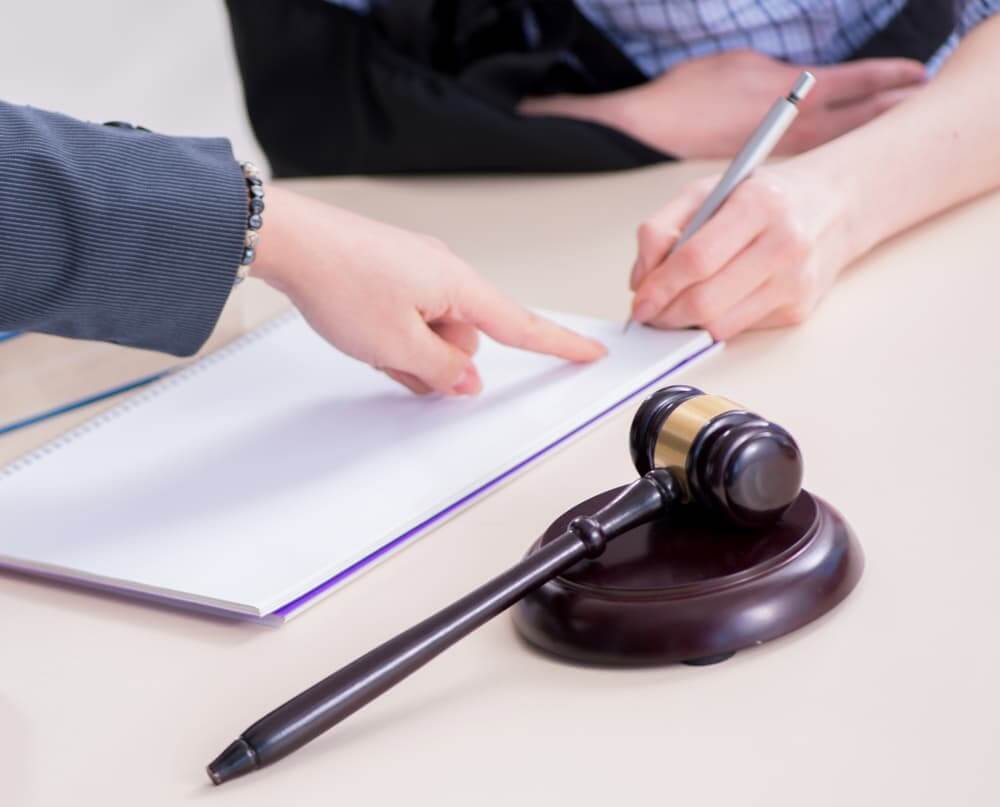When you’re involved in an accident with a rideshare vehicle, such as one operated by Lyft, the aftermath can be confusing and stressful. You might be wondering whether you have legal recourse against Lyft itself, the driver, or another party.
An experienced rideshare accident attorney can assist with every aspect of your case. A lawyer can review the specifics of your collision, including the cause of the crash, to determine who was at fault and whether you can pursue just compensation by filing a lawsuit against Lyft.
The Dangers of Ridesharing Apps like Lyft
Rideshare apps have taken off since they were introduced over a decade ago. Lyft started gaining popularity in 2012 and is now one of the biggest, most recognized rideshare apps.
Lyft and other ridesharing apps provide an easy, convenient way to find rides at any hour. But while ridesharing is beneficial for many, it also has disadvantages.

Ridesharing has contributed to overall road congestion. These apps, like Lyft, have increased traffic time on roads by 4.5 percent. With more cars on the road and greater congestion, more accidents will likely happen.
Along with more traffic, rideshare users are at risk of suffering harm, whether in an accident or by assault. Lyft’s latest safety report, which covers 2020 to 2022, provides the numbers for sexual assaults as well as fatalities resulting from physical assaults and motor vehicle fatalities.
Rideshare apps, like Lyft, provide great advantages. However, with the number of victims that experience injuries and even death, it’s worth a second thought before booking your next ride.
Lyft Driver and Vehicle Requirements
To try to make their services safer, Lyft has various requirements that drivers and their vehicles must meet before prospective drivers can work.
To work for Lyft, drivers must:
- Be at least 21 to 25, depending on the region
- Have at least one year of licensed driving experience (in some states)
- Pass a background check and driving record check
- Have a current driver’s license along with valid registration and insurance
Driving for Lyft requires a safe vehicle. Lyft vehicles must:
- Meet minimum vehicle age requirements, based on the location
- Have four doors with a minimum of five seatbelts
- Pass a vehicle inspection
Lyft imposes these requirements to promote safety and protection for its riders. Still, some drivers and their vehicles fall between the cracks, putting unsafe drivers and their cars on the road and potentially putting riders at risk.
The Basics of Lyft Accidents
Rideshare accidents are common to other types of vehicular collisions. However, certain details add to the complexity of these accidents, especially because a rideshare company is involved and can be liable.
It’s helpful to understand a bit about rideshare accidents if you find yourself injured in a Lyft collision. If you suffer harm in an accident while riding a Lyft, you should not hesitate to seek personalized legal guidance as quickly as possible.
Causes of Lyft Collisions
Rideshare accidents can occur for various reasons, often reflecting dangerous trends in driving behaviors and vehicle safety. Some of the common causes of Lyft collisions include:

- Distracted driving: Rideshare drivers may be distracted by GPS systems, ride requests, or communication with passengers. This distraction can lead to reduced attention to the road.
- Speeding: To meet high demand and maximize earnings, some rideshare drivers speed, increasing the risk of accidents.
- Fatigue: Long hours or irregular shifts can lead to driver fatigue, impairing judgment and reaction times.
- Aggressive driving: Some drivers may exhibit aggressive behavior, such as tailgating or making abrupt lane changes, which can lead to collisions.
- Inexperienced drivers: New drivers or those with limited ride-sharing experience may not be as adept at handling various driving situations.
- Impaired driving: While rideshare companies have strict policies against driving under the influence, occasional lapses do occur.
- Weather conditions: Adverse weather, like rain, snow, or fog, can make driving more hazardous, and drivers may not always adjust their driving appropriately.
- Road conditions: Poorly maintained roads, potholes, or construction zones can contribute to accidents, especially if drivers are not vigilant.
- Vehicle maintenance: Inadequate vehicle maintenance can lead to mechanical failures or other issues that increase the risk of accidents.
It’s important to determine the cause of your Lyft accident, as this can determine who is at fault for the collision and whether Lyft will share in the liability.
Fault for Lyft Accidents
Determining fault for a rideshare accident, especially when two drivers are involved and blaming one another. You can feel like you have very little control over the situation, and getting clarity concerning liability may be challenging.
Often, for a Lyft accident, either the driver of your vehicle or the other driver is at fault. However, depending on the exact cause of the collision, other parties may be fully or partially to blame, including product designers, manufacturers, maintenance companies, or governmental entities. In some cases, Lyft can also be liable.
Many times, rideshare accidents are the result of negligence. When a party is negligent, it means they failed to act in a reasonable manner. Proving negligence requires satisfying four key elements, including:
- Duty: The other party owed you a duty of care.
- Breach: The other party breached their duty to you.
- Causation: The other party’s actions caused your accident.
- Damages: You suffered injuries and losses due to your accident.
Determining and proving fault can be one of the most challenging parts of a rideshare collision claim. However, with the right legal help and evidence, you can hold the responsible party accountable and get one step closer to getting the compensation you need and deserve.
Injuries Often Resulting from Lyft Collisions

Like other types of vehicular collisions, Lyft accidents can result in serious injuries. Some of the injuries rideshare crash victims sustain include:
- Whiplash: A common injury in rear-end collisions where the head and neck are jolted forward and backward, potentially causing strain to the neck muscles and ligaments.
- Back injuries: Injuries to the back can involve herniated discs or lower back strain, which can occur from the force of the impact or from being jolted during the collision.
- Head injuries: These injuries can range from concussions to more severe traumatic brain injuries. Head injuries might occur if there is a direct impact on the head or if the head strikes a hard surface inside the vehicle.
- Chest injuries: Injuries to the chest include rib fractures or bruising, which often result from the seatbelt restraining the victim during the impact.
- Fractures: Broken bones can occur due to the force of the collision, commonly including bones in the arms and legs.
- Soft tissue injuries: These injuries include sprains, strains, and contusions, which can affect muscles, tendons, and ligaments.
- Internal injuries: Internal bleeding or organ damage can be severe and may not be immediately apparent, making it dangerous and crucial to seek medical attention right away.
Along with physical injuries, Lyft collisions can also result in mental and emotional trauma. An accident victim may develop certain disorders, including post-traumatic stress disorder (PTSD), anxiety, or depression. This can significantly impact a person’s well-being and lifestyle.
If you’re injured in a Lyft accident, the financial burdens of your medical expenses can be too much to carry on your own. This is the primary reason to take action and pursue compensation. Discuss your case with a rideshare accident attorney to get the legal support you need.
Damages for Lyft Accidents
Regarding damages for rideshare accidents, you can seek compensation for various losses. The specific damages are unique to your case and depend on the nature and extent of the accident, injuries, and losses. You can pursue financial compensation for:

- Past and future medical expenses
- Lost earnings
- Diminished earning potential
- Property damage
- Pain and suffering
- Disability or impairment
- Loss of enjoyment of life
The damages you pursue for your Lyft accident can help lessen the financial struggles that arise following your collision. A skilled rideshare attorney can assess your case, calculate your damages, and seek full and fair monetary recovery on your behalf.
Understanding Lyft Insurance
While rideshare drivers must carry their own car insurance, Lyft also provides additional liability insurance as an extra layer of protection in the event of a collision. However, Lyft’s liability insurance does not always cover an accident, so it’s essential to understand how it works.
Lyft’s insurance coverage depends on the “status” of the driver at the time of the collision.
When the App is Off, and the Driver is Not Working
When the driver’s Lyft app is off and they are not working, Lyft’s insurance does not cover them. If the driver is involved in a collision, they will need to rely on their own insurance, as Lyft is not involved.
When the App is On, and the Driver is Waiting for a Request
If an accident occurs while a driver is working and waiting for a request, Lyft’s insurance should provide the following coverage:
- $50,000 per person for bodily injury
- $100,000 per accident for bodily injury
- $25,000 per accident for property damage
As long as the driver’s app is on and they’re available for a ride request, Lyft’s insurance protection should kick in, at least partially.
When the Driver is Headed to Pick up the Rider, or They are On the Ride
When the driver is on the way to pick up a passenger, or they have the passenger in their vehicle on the way to drop them off, Lyft’s insurance provides the following protection:
- At least $1 million for third-party auto liability coverage
- First-party coverage, which can include uninsured motorist coverage, underinsured motorist coverage, PIP, and others
Additionally, if a driver obtains comprehensive and collision coverage on their own car insurance policy, Lyft maintains a contingent comprehensive and collision coverage up to the actual value of the car (with a $2,500 deductible).
Filing a Claim Following a Lyft Accident

The process of filing a claim depends on who caused your accident. You may file a claim through your driver’s insurance or another driver’s insurance company. Under other circumstances, you may file a claim through Lyft’s insurance.
Filing a claim through Lyft’s insurance is similar to filing a claim with other insurance companies. You initiate your claim with the insurer, and they investigate the claim and make their decision. Based on the outcome of the initial investigation, you might receive an initial offer. You can engage in further negotiations if the settlement offer is low.
However, if you cannot reach a satisfactory settlement with Lyft’s insurance, you might have the option of taking legal action against the insurance company.
Can You Sue Lyft for Compensation for Your Injuries?
In some cases, yes, it is possible to sue Lyft if you’re injured in an accident. Still, filing a lawsuit against Lyft is no easy task, especially because of the systems they have in place to limit their liability. However, if Lyft’s insurer is unwilling to settle your claim fairly, your attorney can file a lawsuit to pursue justice and compensation.
Additionally, you may have other claims that can open the door to suing. If Lyft’s negligence contributed to your accident, you can file suit against them. These claims often involve negligent hiring and failure to enforce safety standards.
Deciding to sue Lyft comes with additional responsibilities. You must not only prove the extent of your injuries and losses but also how the company’s negligence directly impacted you. This often requires a thorough investigation and collection of strong evidence.
When filing suit against Lyft, you should never take on the challenge alone. A rideshare accident lawyer can guide you in your legal battle.
After Getting Hurt in a Lyft Accident, Discuss Your Case with an Experienced Attorney
Don’t wait to take action if you’re injured in a Lyft accident. A rideshare accident lawyer can review the specifics of your case and provide much-needed guidance concerning your case. Depending on the circumstances, this may include filing a lawsuit against Lyft.
No matter what direction your case takes, you can rely on your lawyer throughout the process. Your personal injury attorney will do everything necessary to get you the compensation you’re owed.
